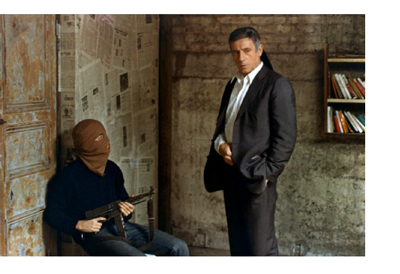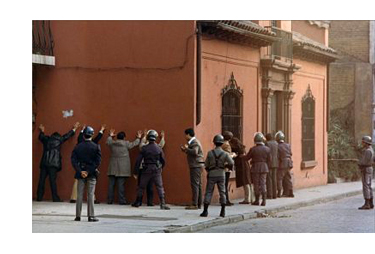
 |
|
|
|
In 1971's The Confession Costa-Gavras surprised conservative critics by taking as his subject the horrors of a 1952 show trial in communist Czechoslovakia. But even the survivors of that purge continue to believe in the rightness of the socialist form of government. The very next year the director made the much more controversial State of Siege, a film that condemns the United States in no uncertain terms. Based on a true story, it has value as a document about the root causes of today's international terrorism. Criterion's extras include NBC TV's full prime time news coverage of the true event that inspired the movie. It's all pretty eye-opening, to say the least. 
In 1970 the Uruguayan urban guerillas Movimiento de Liberación Nacional-Tupamaros, or just Tupemaros, have set up a powerful underground movement, well organized with weapons, safe houses, and Cárceles del Pueblo), secret hiding places for kidnapped enemies. The group snatches Philip Michael Santore (Yves Montand), an American working with an aid organization, the 'U.S. Agency for International Development'. Santore is accidentally wounded. Everyone is shocked by the unprovoked attack meant to embarrass the Uruguayan government. Santore is held with a Brazilian diplomat seized at the same time. Outspoken journalist Carlos Ducas (O.E. Hasse of Alfred Hitchcock's I Confess) doubts the government's explanation. The Tupemaros cleverly smugggle Santore in and out of a hospital to have his gunshot attended to. During his interrogation, they assert that Santore is in reality a military security agent and an expert on torture. He spent years teaching right-wing governments in the Dominican Republic and Brazil how to torture prisoners with electricity. One of the Tupemaros knows this from his experience as a military trainee. The government gathers to debate what to do, and Ducas notes that the ministers are all landowners of vast parcels or owners of large companies, all closely linked with United States corporations. Flashbacks show the torture devices arriving in USAID diplomatic pouches. The trainee witnesses a naked prisoner being tortured on-stage for an audience of uniformed military and police. Probes are attached to all parts of the victim's body, including the eyes. The head of the military anti-Tupemaros squad, Captain López (Renato Salvatori) is modest when speaking with the press, but pushes forward with an efficient plan that captures a number of Tupemaros. After their prison-hideout is almost discovered, the guerillas decide that Santore's usefulness for international publicity has ended. They vote on whether to execute him or set him free. 
Costa-Gavras' fiery film is performed in French, and as such is a 'this is happening now' political movie intended to sway international opinion on what was happening all across South America in the 1960s. To further what are euphemistically called American interests, the U.S. resorted to black ops to help secure governments friendly to U.S. commerce and military influence. It is a fact that the CIA used aid organizations to arm and train police forces to suppress political freedom in these countries, for it was presumed that any regime not rigorously allied with us would side with the dreaded communist bloc. The handsomely filmed movie is positioned halfway between a suspense thriller and a documentary. Costa-Gavras' all-purpose leftist collaborator Yves Montand stars again, but this time without Simone Signoret. Montand had been associated with films critical of the U.S. exploitation of Latin America since 1953's The Wages of Fear. The Tupemaros snatch Santore off the street in a coordinated effort that puts our sloppy would-be urban guerillas to shame. The American torture-teacher is locked away in a fairly secure hideout, with newspapers on the walls so that he won't even be able to describe his cell. Santore likes that, and the fact that his kidnappers all wear hoods: it means he has a chance of being let go. 
There's no question that the movie is an advocacy piece, a document trying to explain the covert doings of one country to politically and economically dominate an entire hemisphere. The effectiveness of State of Siege can be judged by its relative obscurity: in 1972 Watergate hadn't happened and the Pentagon Papers were barely out. People have always had so little interest in political actions far from home, especially when it is easily ignored, that it is difficult to gauge the usefulness of films like State of Siege. I remember it showing at one theater maybe for a week or two, with little publicity except in the 'free press' papers (that mostly no longer exist. Yet it seems an important film for understanding the modern world. As literally every other South American country in 1970 was dominated by pro- U.S. regimes, Costa-Gavras filmed State of Siege in Chile, where the freely-elected Allende government was trying its best to make sure that the unseated oligarchs had a voice in government. Locations in Santiago, Viña del Mar, and Valparaíso stand in for Uruguay's Montevideo. Just a year later, a military coup organized and directed by the CIA overthrew the elected Chilean government and plunged it into fifteen years of military dictatorship. 
Despite its obvious anti-U.S. stance, State of Siege does not have much good to say about urban guerillas like the Tupemaros. As soon as the violence becomes disruptive, any citizen with a stake in the status quo will side with whatever repressive measures will restore order. In the end the Tupemaros will be lumped in with organizations like the misdirected Weather Underground and the mad-dog terrorists The Baader-Meinhof Gang. Costa-Gavras' work to influence public opinion is an uphill battle, to be sure. His fictional Betrayed from 1988 is about a militant white supremacist group in the Midwest. Its combination of movie stars and radical politics almost trivializes its subject. Not so the director's 1982 Missing with Sissy Spacek and Jack Lemmon, which made the biggest impact since his "Z" back in 1969. What real effect did these films have, besides reaching viewers like myself? Despite sometimes being poorly distributed, they sometimes win awards. Then Hollywood is accused of being run by left-wing propagandists. 1 |
|||||||||||||||||||
Review Staff | About DVD Talk | Newsletter Subscribe | Join DVD Talk Forum
Copyright © MH Sub I, LLC dba Internet Brands. | Privacy Policy
Subscribe to DVDTalk's Newsletters
|